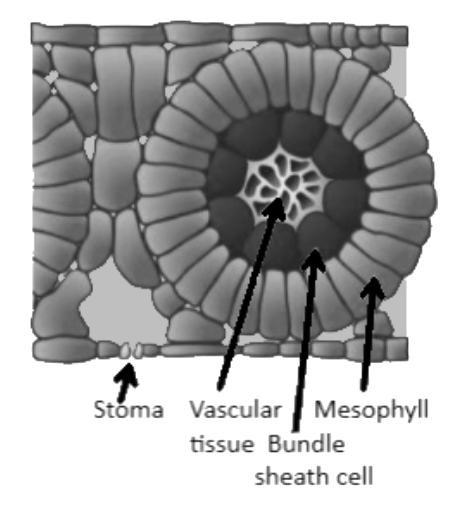
In
A. Have thin walls to facilitate gaseous exchange
B. Have large intercellular spaces
C. Are rich in PEP carboxylase
D. Have a high density of chloroplast.
Answer
497.7k+ views
Hint: The
Complete answer:

- Bundle sheath cells have walls that are impervious for gaseous exchange but the walls are thick. If the walls are thin the gaseous exchange will occur but these cells do not involve gaseous exchange. So the option is not correct.
- These cells have no intercellular spaces between them . These cells are present so closely that bundle sheath cells and mesophyll cells have no space between them. So this option is also incorrect.
- They are rich in RuBisCO the enzyme which has affinity for both carbon dioxide and oxygen but lacks PEP( phosphoenolpyruvate) carboxylase. Hence this option is not correct.
- They are specialised for photosynthesis the plant performs its own food due to this pathway so they have more chlorophyll which means more chloroplast. Hence this option is not correct.
Hence, the correct answer is option (D).
Note: Bundle sheath cells have large numbers of chloroplast. They do not possess grana. They have thick walls that are impervious to gaseous exchange and have no intercellular spaces. So
Complete answer:

- Bundle sheath cells have walls that are impervious for gaseous exchange but the walls are thick. If the walls are thin the gaseous exchange will occur but these cells do not involve gaseous exchange. So the option is not correct.
- These cells have no intercellular spaces between them . These cells are present so closely that bundle sheath cells and mesophyll cells have no space between them. So this option is also incorrect.
- They are rich in RuBisCO the enzyme which has affinity for both carbon dioxide and oxygen but lacks PEP( phosphoenolpyruvate) carboxylase. Hence this option is not correct.
- They are specialised for photosynthesis the plant performs its own food due to this pathway so they have more chlorophyll which means more chloroplast. Hence this option is not correct.
Hence, the correct answer is option (D).
Note: Bundle sheath cells have large numbers of chloroplast. They do not possess grana. They have thick walls that are impervious to gaseous exchange and have no intercellular spaces. So
Latest Vedantu courses for you
Grade 11 Science PCM | CBSE | SCHOOL | English
CBSE (2025-26)
School Full course for CBSE students
₹41,848 per year
Recently Updated Pages
Master Class 11 Business Studies: Engaging Questions & Answers for Success

Master Class 11 Accountancy: Engaging Questions & Answers for Success

Master Class 11 Computer Science: Engaging Questions & Answers for Success

Master Class 11 English: Engaging Questions & Answers for Success

Master Class 11 Social Science: Engaging Questions & Answers for Success

Master Class 11 Economics: Engaging Questions & Answers for Success

Trending doubts
Which one is a true fish A Jellyfish B Starfish C Dogfish class 11 biology CBSE

State and prove Bernoullis theorem class 11 physics CBSE

1 ton equals to A 100 kg B 1000 kg C 10 kg D 10000 class 11 physics CBSE

In which part of the body the blood is purified oxygenation class 11 biology CBSE

One Metric ton is equal to kg A 10000 B 1000 C 100 class 11 physics CBSE

Difference Between Prokaryotic Cells and Eukaryotic Cells




